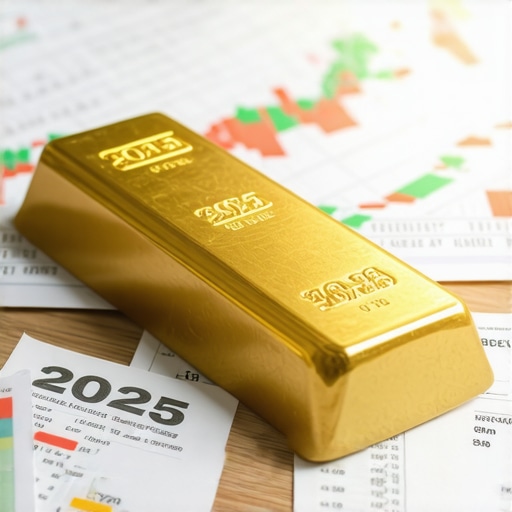Unlocking the Power of Gold ETFs & Mutual Funds: A Strategic Perspective for 2025
As the global financial landscape becomes increasingly complex, investors seeking resilience and growth are turning towards sophisticated asset classes like gold-based ETFs and mutual funds. These instruments, rooted in both traditional and modern portfolio theory, offer unique opportunities for diversification, inflation hedging, and risk mitigation in 2025. Understanding the nuanced dynamics of gold markets—such as supply-demand fluctuations, geopolitical influences, and macroeconomic trends—is essential for constructing a resilient investment strategy.
The Evolution of Gold Investment Vehicles: From Physical Gold to Financialized Instruments
Historically, physical gold—coins and bullion—served as a store of value. However, the advent of exchange-traded funds (ETFs) and mutual funds has revolutionized access to gold, providing liquidity, ease of management, and diversification. Gold ETFs, like SPDR Gold Shares, track spot prices efficiently, while mutual funds offer active management and thematic exposure, such as mining shares or gold streaming companies. These vehicles facilitate exposure to gold’s intrinsic value without the logistical challenges of physical storage.
Advanced Portfolio Diversification: Beyond Traditional Asset Allocation
Incorporating gold ETFs and mutual funds into a 2025 portfolio can significantly enhance diversification. Gold’s negative correlation with equities and bonds during market downturns acts as a hedge against systemic risks. Moreover, analyzing supply-demand dynamics—such as central bank gold purchases or emerging jewelry markets—provides deeper insights into future price trajectories. For instance, recent trends indicate increased central bank reserves, which could support prices amidst geopolitical tensions.
Expert Question: How Can Investors Optimize Gold ETF & Mutual Fund Allocation Amidst Market Volatility?
Effective allocation requires a disciplined approach, integrating macroeconomic analysis, technical indicators, and supply-demand fundamentals. Diversification within gold investments—spanning physical gold, ETFs, and mining stocks—can mitigate sector-specific risks. Additionally, leveraging supply-demand research enhances timing and positioning strategies. Active management, including tactical rebalancing aligned with market signals, can maximize gains during volatile periods.
Harnessing Gold’s Role as an Inflation Hedge in 2025
One of the most compelling reasons for integrating gold into portfolios is its historical efficacy as an inflation hedge. As inflationary pressures persist due to monetary easing and geopolitical uncertainties, gold’s real returns remain attractive. Utilizing instruments like gold ETFs and mutual funds can provide flexible exposure, enabling investors to adapt swiftly to evolving macroeconomic conditions.
What Are the Hidden Risks of Relying on Gold ETFs & Mutual Funds in a High-Inflation Environment?
While gold investments offer diversification benefits, they are not without risks. Price volatility driven by macroeconomic shocks, regulatory changes, or shifts in investor sentiment can impact returns. Furthermore, the potential for tracking errors in ETFs and management fees in mutual funds must be carefully considered. A comprehensive risk assessment, including scenario analysis and stress testing, is vital for safeguarding wealth.
Investors seeking authoritative insights should consult sources like the IMF’s research on gold’s role in financial stability. Exploring top trends in gold demand can further refine strategic positioning for 2025.
For those aiming to deepen their expertise, consider reviewing comprehensive guides on best gold ETFs and mutual funds for 2025 and exploring innovative strategies like gold futures trading for optimized portfolio performance.
Leveraging Macro Trends and Behavioral Insights in Gold Investment Strategies
To refine your gold investment approach in 2025, it’s crucial to incorporate macroeconomic trends and investor behavior patterns. For instance, understanding how geopolitical tensions influence gold prices can guide tactical asset allocation. As noted by the experts in supply-demand analysis, shifts in global political stability often trigger surges in gold demand, especially in emerging markets and central bank reserves. Recognizing these patterns enables investors to anticipate price movements and adjust their portfolios proactively.
Can Behavioral Finance Unlock Hidden Opportunities in Gold Markets?
Behavioral finance suggests that investor psychology, such as herd behavior or risk aversion, can significantly impact gold prices. During periods of uncertainty, panic buying may temporarily inflate prices beyond fundamental valuations, presenting contrarian opportunities. Conversely, overconfidence can lead to overexposure, increasing risk exposure. Employing tools like sentiment analysis and market psychology frameworks—discussed in detailed financial research—can help investors capitalize on these behavioral patterns while avoiding common pitfalls. For a comprehensive understanding, see the article on top trends in gold demand.
What Are the Practical Tools for Advanced Gold Portfolio Management?
Modern investors benefit from sophisticated tools such as dynamic rebalancing algorithms, risk parity models, and scenario analysis platforms. These tools allow for real-time adjustments aligned with macroeconomic indicators, supply-demand shifts, and geopolitical developments. For example, integrating gold futures strategies can enhance leverage and hedging capabilities, especially during volatile market phases. Combining these techniques with insights from economic factor analysis can optimize portfolio resilience and growth potential in 2025.
Interested in more sophisticated techniques? Consider exploring the latest developments in gold ETFs and mutual funds or leveraging futures trading to amplify your strategic positioning.
Harnessing the Synergy of Gold ETFs & Mutual Funds: Advanced Strategies for 2025
As the financial environment grows more intricate, sophisticated investors are increasingly leveraging the unique attributes of gold-based ETFs and mutual funds to refine their portfolios. These instruments serve not only as hedges against inflation but also as dynamic tools for tactical asset allocation, especially amid geopolitical tensions and macroeconomic shifts. The challenge lies in mastering their nuanced behavior—understanding their correlations, risk profiles, and strategic deployment in volatile markets.
The Intersection of Supply-Demand Dynamics and Price Volatility
To optimize gold investments, a profound grasp of supply-demand fundamentals is paramount. For example, recent data from the SMA Metal Bulletin reveals that central banks have been net buyers of gold for five consecutive years, signaling a shift towards a more bullish long-term outlook. Simultaneously, the rise in jewelry demand in emerging markets like India and China underscores the importance of regional consumption patterns. These forces contribute to short-term price swings but also inform strategic entry and exit points—especially critical for tactical investors.
How Can Investors Quantify the Impact of Geopolitical Events on Gold Prices?
Integrating geopolitical risk assessments into quantitative models enhances predictive accuracy. Techniques include sentiment analysis of news flows, geopolitical event calendars, and macroeconomic indicator overlays. For example, tracking escalation timelines in trade disputes or conflicts can provide early signals of increased gold demand as a safe haven, allowing investors to reallocate positions proactively. Sophisticated tools like machine learning algorithms—referenced in recent academic research—can automate and refine this process, offering a strategic edge.

Integrating Gold ETFs & Mutual Funds with Other Asset Classes for Resiliency
Beyond standalone allocation, integrating gold instruments with equities, bonds, and alternative assets creates a resilient multi-layered defense. Dynamic rebalancing algorithms, supported by real-time macroeconomic data, enable portfolio adjustments that respond swiftly to market signals. For instance, during inflation surges, increasing exposure to gold through ETFs can offset bond and equity declines, preserving capital. Conversely, in periods of economic stability, trimming gold holdings can free capital for growth assets.
Behavioral Finance and Market Sentiment: Unlocking Hidden Opportunities
Behavioral biases—such as panic buying during crises or overconfidence in bullish phases—can distort gold prices from fundamental values. Recognizing these patterns allows astute investors to capitalize on contrarian opportunities. Sentiment analysis tools, including social media monitoring and market psychology indices, can identify when irrational exuberance or fear dominates, guiding entry or exit decisions. For example, a spike in collective risk aversion often precedes a gold price rally, presenting a strategic entry point.
Developing a Tactical Framework for Gold Investment in 2025
Implementing a tactical framework involves leveraging advanced analytical tools—scenario analysis, stress testing, and Monte Carlo simulations—to evaluate potential outcomes under varying macroeconomic conditions. Incorporating derivatives like gold futures and options can further enhance flexibility, allowing for hedging and leverage. Moreover, staying attuned to technological innovations such as blockchain-enabled gold trading platforms can provide additional transparency and efficiency, aligning with the evolving landscape of digital finance.
Interested in deepening your strategic approach? Continually explore latest research, refine your models with real-time data, and consider consulting with financial analysts specialized in precious metals. The path to mastering gold investments in 2025 involves a blend of rigorous analysis, behavioral insight, and technological agility—empowering you to navigate complexities with confidence.
Harnessing Quantitative Models for Precision in Gold Investment Strategies
To elevate your gold investment approach in 2025, integrating quantitative analysis through advanced models such as Monte Carlo simulations and scenario planning becomes indispensable. These techniques enable investors to evaluate potential outcomes across diverse macroeconomic environments, assessing risk and return profiles with greater accuracy. By employing robust data inputs—incorporating geopolitical risk indices, supply-demand variables, and macroeconomic indicators—investors can craft resilient portfolios optimized for volatility and systemic shocks.
Innovative Use of Blockchain Technology in Gold Trading and Custody
The advent of blockchain platforms is revolutionizing gold trading, offering unprecedented transparency, security, and efficiency. Distributed ledger technology facilitates real-time tracking of gold provenance, reduces counterparty risk, and streamlines settlement processes. Institutions utilizing blockchain-enabled custody solutions can ensure authenticity and traceability of gold holdings, fostering investor confidence and compliance with regulatory standards. Exploring these innovations provides a strategic edge in managing physical gold exposure within ETF and mutual fund frameworks.
What Are the Critical Considerations for Regulatory Compliance in Gold Investment Vehicles?
Regulatory landscapes are continually evolving, impacting the operation and transparency of gold ETFs and mutual funds. For instance, compliance with standards set by authorities such as the SEC or ESMA involves stringent disclosure requirements, custody rules, and liquidity provisions. Staying abreast of legal developments, such as changes in derivatives regulation or cross-border trading restrictions, is vital for safeguarding assets and ensuring strategic flexibility. Consulting specialized legal and compliance experts can mitigate risks associated with regulatory shifts, ensuring sustained operational integrity.
How Can Investors Leverage Machine Learning for Market Sentiment Analysis?
Machine learning algorithms, including natural language processing (NLP), enable sophisticated sentiment analysis by parsing vast datasets—news feeds, social media, and expert commentary—to gauge market psychology around gold. These insights can predict short-term price movements, identify emerging trends, and inform tactical entry or exit points. Integrating sentiment signals with fundamental supply-demand data enhances decision-making precision, particularly during geopolitical upheavals or macroeconomic shocks. Refer to recent academic research, such as the study available at PLOS ONE on machine learning in financial markets, for comprehensive methodologies.
How Do Geopolitical Risks Interact with Gold Price Dynamics in a Complex Global Environment?
Geopolitical risks—including trade conflicts, regional insurgencies, and diplomatic tensions—exert profound influence on gold prices as safe-haven assets. Quantitative models incorporating geopolitical event calendars, diplomatic risk indices, and escalation timelines can enhance predictive accuracy. For example, tracking geopolitical event severity and frequency through news sentiment and real-time risk assessments aids in proactive portfolio adjustments. By integrating these complex variables into multi-factor models, investors can better navigate volatility and capitalize on safe-haven inflows during crises.

Enhancing Portfolio Resilience through Diversification with Alternative Assets
Beyond traditional asset classes, integrating commodities such as silver, platinum, or even cryptocurrencies with gold holdings can diversify systemic risks and improve overall portfolio robustness. Sophisticated optimization algorithms, including mean-variance and risk parity models, facilitate balanced allocations that adapt dynamically to shifting market conditions. Moreover, exploring emerging asset classes—like tokenized gold—offers liquidity and fractional ownership benefits, aligning with modern portfolio management paradigms. Continuous research into these innovative avenues can unlock new frontiers for strategic growth in 2025.
Deep Behavioral Analysis: Detecting Market Psychology Anomalies in Gold Markets
Behavioral finance tools such as anomaly detection algorithms and investor sentiment indices help uncover irrational exuberance or panic-driven behavior that distorts gold prices. Recognizing divergence between fundamental valuation and market sentiment enables contrarian strategies—buying during overreactions or selling during euphoria. Implementing real-time sentiment analytics, combined with technical indicators and macroeconomic signals, empowers investors to exploit behavioral biases while managing associated risks. Exploring these psychological patterns offers a competitive advantage in complex market environments.
Integrating Digital Finance Innovations for Strategic Edge
The rapid evolution of digital finance—through decentralized finance (DeFi) protocols, tokenized assets, and AI-driven trading platforms—creates unprecedented opportunities for gold investors. Utilizing blockchain-based gold tokens provides fractional ownership, enhanced liquidity, and seamless cross-border transactions. AI-driven trading algorithms can execute strategies at speeds unachievable manually, optimizing timing and execution. Staying attuned to these technological innovations and integrating them into your strategic framework can significantly enhance agility and profitability in 2025.
Engage deeply with these advanced insights, continually refine your models with real-time data, and consider collaborating with specialized financial technologists to harness the full potential of sophisticated gold investment strategies. The future of gold investing in 2025 lies in innovative, data-driven, and technologically integrated approaches that empower informed, agile decision-making.
Expert Insights & Advanced Considerations
1. Diversification Strategies Require Dynamic Adjustment
In 2025, sophisticated investors recognize that static allocation to gold ETFs and mutual funds must evolve with macroeconomic shifts, geopolitical tensions, and technological innovations. Continuous portfolio rebalancing, leveraging real-time data and predictive analytics, enhances resilience and capitalizes on emerging opportunities.
2. Blockchain and Digital Asset Integration Are Game-Changers
The adoption of blockchain technology in gold trading and custody offers unprecedented transparency and security. Integrating tokenized gold assets into traditional portfolios can improve liquidity, fractional ownership, and cross-border accessibility, redefining modern investment paradigms.
3. Advanced Quantitative Models Are Essential
Employing tools like Monte Carlo simulations, scenario analysis, and machine learning-driven sentiment analysis enables high-precision risk assessment and strategic positioning. These techniques help anticipate market swings driven by supply-demand dynamics and geopolitical events, optimizing decision-making.
4. Behavioral Finance Offers Hidden Opportunities
Understanding investor sentiment, herd behavior, and irrational exuberance through behavioral finance tools allows contrarian positioning, especially during market overreactions. Sentiment indices and social media analytics are invaluable for timing entries and exits effectively.
5. Regulatory and Technological Monitoring Is Critical
Staying ahead of evolving regulations in derivatives, cross-border trading, and digital assets ensures compliance and strategic agility. Embracing innovations like AI-powered compliance tools and digital finance platforms enhances operational efficiency and risk mitigation.
Curated Expert Resources
- IMF’s Research on Gold’s Role in Modern Portfolios: Offers in-depth analysis of gold’s strategic importance, macroeconomic impacts, and policy considerations—an essential resource for high-level strategists.
- Blockchain in Precious Metals: Industry Reports: Provides insights into technological advancements, integration strategies, and security protocols transforming gold investment management.
- Advanced Quantitative Finance Journals: Journals like the Journal of Financial Markets publish cutting-edge research on simulation techniques, market microstructure, and behavioral analytics applicable to gold portfolios.
- Market Sentiment & Behavioral Analytics Platforms: Tools such as StockTwits and MarketPsych enable real-time sentiment tracking and behavioral analysis, critical for tactical decision-making in volatile environments.
- Regulatory Frameworks & Compliance Guidelines: Resources from SEC, ESMA, and other regulators provide essential updates on legal standards affecting gold ETFs, mutual funds, and digital assets—vital for maintaining compliance and strategic stability.
Final Expert Perspective
Mastering the art of gold ETF and mutual fund investment in 2025 hinges on integrating advanced quantitative models, embracing blockchain innovations, and understanding behavioral and regulatory landscapes. These elements collectively empower investors to craft resilient, high-performing portfolios amid ongoing global uncertainties. Engage with these expert resources to deepen your strategic insights, and consider collaborating with financial technologists and policy advisors to stay ahead in this dynamic environment. The future of gold investment is not just about holding assets but about leveraging technology, data, and behavioral intelligence for sustained success.











This comprehensive post offers excellent insights into how sophisticated investors can strategically leverage gold ETFs and mutual funds in 2025. I especially appreciate the emphasis on integrating behavioral analytics and technological innovations like blockchain for portfolio resilience. From my experience, combining quantitative risk models with real-world geopolitical risk assessments has been crucial in navigating volatile markets. One aspect I find particularly challenging is timing tactical rebalancing effectively, especially when market sentiment shifts rapidly. Have others found particular tools or indicators most reliable for making these quick adjustments to gold allocations? It seems that staying ahead requires continuous learning and adaptation, especially as digital finance continues to evolve.